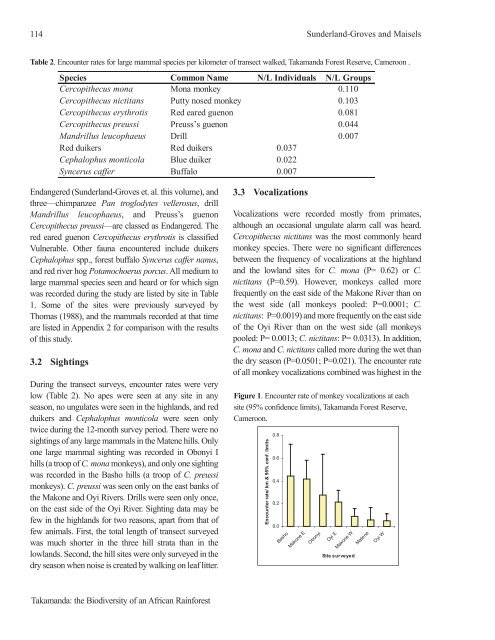Fisheries in the Southern Border Zone of Takamanda - Impact ...
Fisheries in the Southern Border Zone of Takamanda - Impact ...
Fisheries in the Southern Border Zone of Takamanda - Impact ...
Create successful ePaper yourself
Turn your PDF publications into a flip-book with our unique Google optimized e-Paper software.
114 Sunderland-Groves and Maisels<br />
Table 2. Encounter rates for large mammal species per kilometer <strong>of</strong> transect walked, <strong>Takamanda</strong> Forest Reserve, Cameroon .<br />
Species Common Name N/L Individuals N/L Groups<br />
Cercopi<strong>the</strong>cus mona Mona monkey 0.110<br />
Cercopi<strong>the</strong>cus nictitans Putty nosed monkey 0.103<br />
Cercopi<strong>the</strong>cus erythrotis Red eared guenon 0.081<br />
Cercopi<strong>the</strong>cus preussi Preuss’s guenon 0.044<br />
Mandrillus leucophaeus Drill 0.007<br />
Red duikers Red duikers 0.037<br />
Cephalophus monticola Blue duiker 0.022<br />
Syncerus caffer Buffalo 0.007<br />
Endangered (Sunderland-Groves et. al. this volume), and<br />
three—chimpanzee Pan troglodytes vellerosus, drill<br />
Mandrillus leucophaeus, and Preuss’s guenon<br />
Cercopi<strong>the</strong>cus preussi—are classed as Endangered. The<br />
red eared guenon Cercopi<strong>the</strong>cus erythrotis is classified<br />
Vulnerable. O<strong>the</strong>r fauna encountered <strong>in</strong>clude duikers<br />
Cephalophus spp., forest buffalo Syncerus caffer nanus,<br />
and red river hog Potamochoerus porcus. All medium to<br />
large mammal species seen and heard or for which sign<br />
was recorded dur<strong>in</strong>g <strong>the</strong> study are listed by site <strong>in</strong> Table<br />
1. Some <strong>of</strong> <strong>the</strong> sites were previously surveyed by<br />
Thomas (1988), and <strong>the</strong> mammals recorded at that time<br />
are listed <strong>in</strong> Appendix 2 for comparison with <strong>the</strong> results<br />
<strong>of</strong> this study.<br />
3.2 Sight<strong>in</strong>gs<br />
Dur<strong>in</strong>g <strong>the</strong> transect surveys, encounter rates were very<br />
low (Table 2). No apes were seen at any site <strong>in</strong> any<br />
season, no ungulates were seen <strong>in</strong> <strong>the</strong> highlands, and red<br />
duikers and Cephalophus monticola were seen only<br />
twice dur<strong>in</strong>g <strong>the</strong> 12-month survey period. There were no<br />
sight<strong>in</strong>gs <strong>of</strong> any large mammals <strong>in</strong> <strong>the</strong> Matene hills. Only<br />
one large mammal sight<strong>in</strong>g was recorded <strong>in</strong> Obonyi I<br />
hills (a troop <strong>of</strong> C. mona monkeys), and only one sight<strong>in</strong>g<br />
was recorded <strong>in</strong> <strong>the</strong> Basho hills (a troop <strong>of</strong> C. preussi<br />
monkeys). C. preussi was seen only on <strong>the</strong> east banks <strong>of</strong><br />
<strong>the</strong> Makone and Oyi Rivers. Drills were seen only once,<br />
on <strong>the</strong> east side <strong>of</strong> <strong>the</strong> Oyi River. Sight<strong>in</strong>g data may be<br />
few <strong>in</strong> <strong>the</strong> highlands for two reasons, apart from that <strong>of</strong><br />
few animals. First, <strong>the</strong> total length <strong>of</strong> transect surveyed<br />
was much shorter <strong>in</strong> <strong>the</strong> three hill strata than <strong>in</strong> <strong>the</strong><br />
lowlands. Second, <strong>the</strong> hill sites were only surveyed <strong>in</strong> <strong>the</strong><br />
dry season when noise is created by walk<strong>in</strong>g on leaf litter.<br />
<strong>Takamanda</strong>: <strong>the</strong> Biodiversity <strong>of</strong> an African Ra<strong>in</strong>forest<br />
3.3 Vocalizations<br />
Vocalizations were recorded mostly from primates,<br />
although an occasional ungulate alarm call was heard.<br />
Cercopi<strong>the</strong>cus nictitans was <strong>the</strong> most commonly heard<br />
monkey species. There were no significant differences<br />
between <strong>the</strong> frequency <strong>of</strong> vocalizations at <strong>the</strong> highland<br />
and <strong>the</strong> lowland sites for C. mona (P= 0.62) or C.<br />
nictitans (P=0.59). However, monkeys called more<br />
frequently on <strong>the</strong> east side <strong>of</strong> <strong>the</strong> Makone River than on<br />
<strong>the</strong> west side (all monkeys pooled: P=0.0001; C.<br />
nictitans: P=0.0019) and more frequently on <strong>the</strong> east side<br />
<strong>of</strong> <strong>the</strong> Oyi River than on <strong>the</strong> west side (all monkeys<br />
pooled: P= 0.0013; C. nictitans: P= 0.0313). In addition,<br />
C. mona and C. nictitans called more dur<strong>in</strong>g <strong>the</strong> wet than<br />
<strong>the</strong> dry season (P=0.0501; P=0.021). The encounter rate<br />
<strong>of</strong> all monkey vocalizations comb<strong>in</strong>ed was highest <strong>in</strong> <strong>the</strong><br />
Figure 1. Encounter rate <strong>of</strong> monkey vocalizations at each<br />
site (95% confidence limits), <strong>Takamanda</strong> Forest Reserve,<br />
Cameroon.<br />
Encounter rate/ km & 95% conf. limits<br />
0.8<br />
0.6<br />
0.4<br />
0.2<br />
0.0<br />
Basho<br />
Makone E<br />
Obonyi<br />
Oyi E<br />
Makone W<br />
Matene<br />
Oyi W<br />
Site surveyed

















